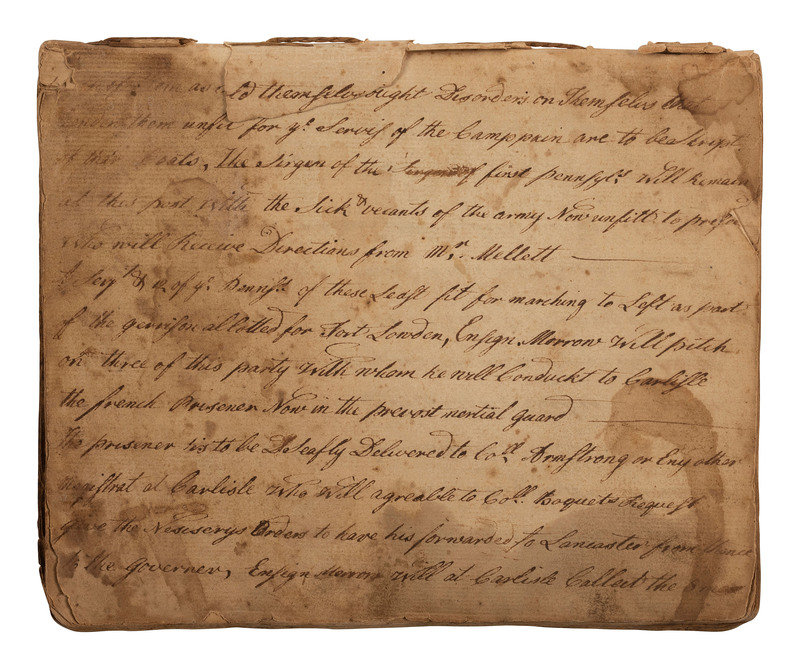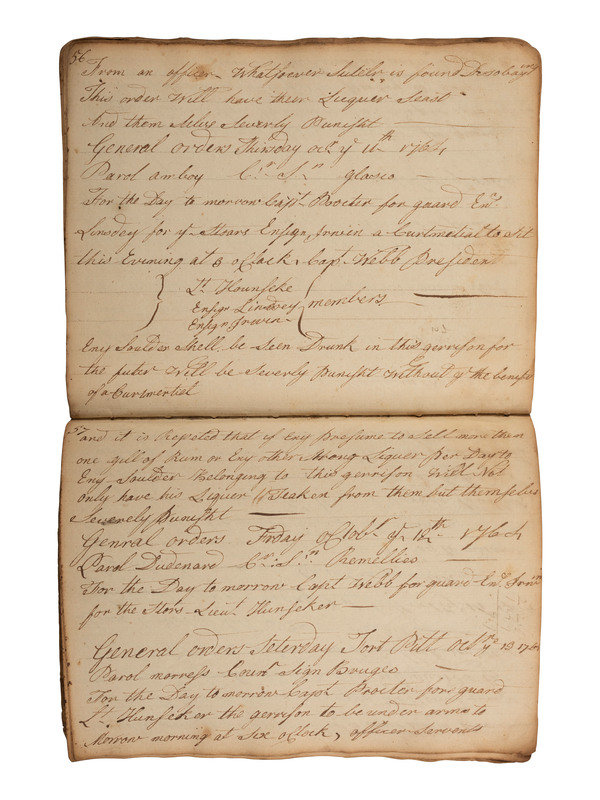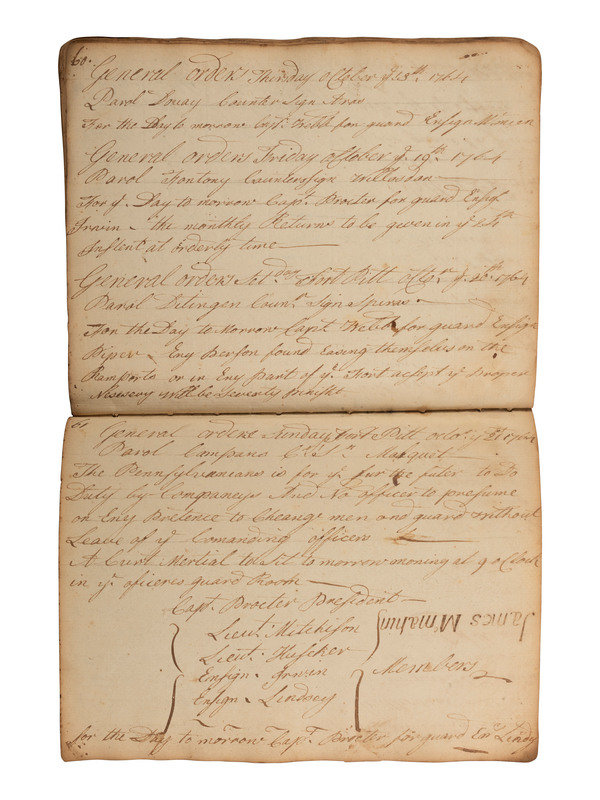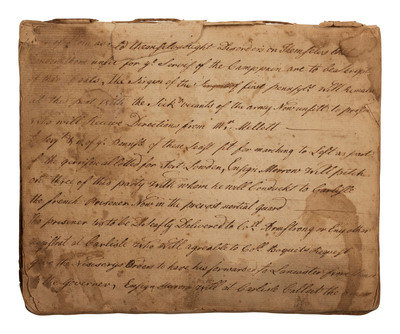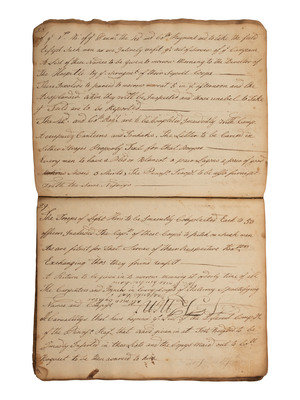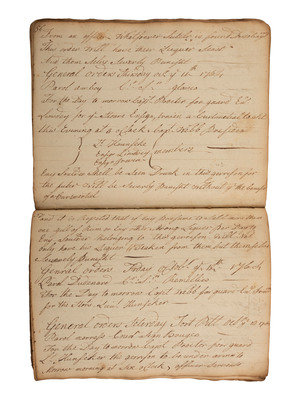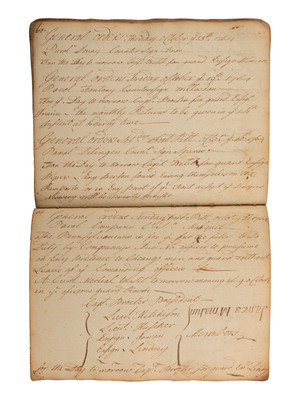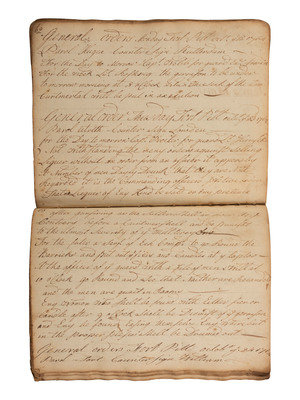Condition Report
Contact Information
Auction Specialist
Lot 3
Lot Description
Approx. 7 1/2 x 6 1/4 in. manuscript orderly book, 36 sewn laid-paper leaves with entries on both sides of the sheets, comprising 68pp. of text, and an additional 17 full and clipped pages of receipts. Lacking covers and the first two pages of entries, the account chronicles the daily march of Colonel Henry Bouquet’s force of British, Pennsylvania and Virginia volunteers during the so-called “Pontiac Conspiracy” or “Rebellion” of 1764. Entries document the period between around 30 August 1764, and 30 November of the same year, with several gaps. The writer is unknown.
Two of the three original Bouquet orderly books are curated at the William Clements Library at the University of Michigan. Bouquet’s daily directives were transmitted and copied by various regimental adjutants, and this is more than likely one of these. Given the frequent reference to Pennsylvania troops and officers, it is assumed that the book was penned by an adjutant associated with one of these regiments.
Written in a confident, but semi-literate hand, each day’s entry records the daily password and countersign to be used, as well as the name of the Field officer(s) and adjutant for the day, along with general orders for the troops. Typically, these include what troops are to lead and follow the column, along with the placement of the horsemen, artillery, baggage train and cattle, and reveal the careful planning of the march. Bouquet wanted no surprises.
The uprising began in the spring of 1763 when various Ohio Country and eastern Illinois Country native groups attacked a series of British forts, hoping to drive the foreigners out of their territories. While many native leaders joined in the conflict, it has historically been identified with the Odawa leader Pontiac and is often known as the Pontiac Conspiracy or Rebellion.
Native groups in New France had traditionally been allied with the French, who were relatively few in number and adopted a more or less laissez faire attitude towards Native Groups. After the Treaty of Paris in February 1763, Britain laid claim to the former lands of New France. Under the command of General Geoffrey Amherst, the Crown began to implement policies which alienated native groups -- who had thought the British would abandon their claims to the lands (and peoples) of New France. That spring and summer combined Indian forces laid siege to Forts Detroit and Pitt and captured eight others across a broad swath of the Ohio and Illinois country. By the spring and early summer of 1764, colonists in Virginia, Maryland and Pennsylvania came under increasing attack. Amherst was blamed and recalled to London.
In response, the British launched two expeditions to the West, one aimed at reinforcing Fort Detroit led by Colonel John Bradstreet, and the other, aimed at Fort Pitt, led by Colonel Henry Bouquet. The journal begins as Bouquet is mustering forces in eastern Pennsylvania to march west to Fort Pitt to confront Native warriors whose aim was to drive the British out of the territory traditionally known as New France.
Bouquet began organizing troops in late August, and by early September had left Fort Loudon in eastern Pennsylvania with 1500 British regulars and regiments of Pennsylvania and Virginia troops. The orderly book offered here begins with a partial entry on August 29th outlining the order of march.
By the 30th with troops underway, the journal records that discipline among the troops was being dealt with harshly. “The sentences…passed by the court martial of the Line of which Capt. Wm. Piper was princpl…and their punishment…to be afflicted (sic) on the general parade this morning at 9 AM in the presence of guards.” Tents were to be struck the following morning at daybreak with the march to Fort Pitt to commence.
By the 3rd of September the column had reached Fort Bedford, and Bouquet ordered “Thanks to be given to Capt. Williams Chiefe Engineer and the officers and soulders…for completing the new rode of the Sidling hill…in the future to be called “Captain Williams Gap”.
On the 6th, encamped at Fort Bedford, troops were ordered to withdraw any “shot” from their loaded arms, all arms to be examined by an officer, and all arms from which shot cannot be withdrawn collected with preparations to march the next day with each man drawing two days rations. The writer notes that Bouquet had noticed that “There has been some abuses diluted in ye prov returns” and that officers are to take care.
There are no entries between September 7th and the 20th. By the 20th, the column had arrived at Fort Pitt, and was preparing to cross the Ohio River into the Ohio country. Part of the preparations included sharpening the shooting skills of the troops. “The Penns. Riflemen to be under arms to morrow morning as soon as the guards are marched (martialed) they will again shoot at marks….” Five rounds were to be expended, with five additional rounds to be used for the next day. “Whoever maks ye best shot…will receive a prisement of 3 dolers ye next best….will receive 2 dollars and the next best…will receive 1 doller…”
On September 21, the troops were given the orders to prepare to march. All were to be outfitted with canteens and tomahawks (the latter to be carried in leather straps), a blanket, a pair of leggings, shirt, and a pair of good shoes.
September 23. Orders given to allow only a single woman and two nurses to accompany each corps. “No exceptions will be maid….it will be in vain for eny other woman to attempt to follying ye troops.”
On the 24th a General Order was given for 100 troops of each unit of the Regulars and 10 from each militia regiment to form a three-sided square one week later to witness the execution of one Frances Steedwell who had been court martialed and found guilty for desertion.
A General Order on Friday, September 28th commanded that 20th and 60th Royal Grendiers along with the Pennsylvania and Virginia militia to cross the Ohio under the command of Lt. Col. Frances. Colonel Bouquet reported that a “parcel of Mohack and other friendly Indians” were being sent to join the force to “prevent any mistakes happens that might hurt our frienes.”
By the first of October the main force had crossed the Ohio, leaving a small garrison at Fort Pitt. The writer of this manuscript was one of the men who remained behind. From this point forward the daily entries are shorter but containing interesting details about life at Fort Pitt during the absence of the larger column, now in the Ohio Country. Orders are given to clean out “the dirt” from each cabin, for axe men to leave the fort to cut wood, to gather corn and vegetables, what time lights are to be extinguished (9 pm), no burning of fence rails, and perhaps most importantly, prohibiting the sale of more than one gill of alcohol daily. By October 23, the sale of all alcohol was completely prohibited.
There is a significant gap in the entries after October 27th and November 30th, when the last entry is made – in a seemingly different hand. By this point the main force had returned to Fort Pitt. Another deserter was found guilty and sentenced to be shot to death, but Colonel Bouquet was to plead to General Gage for a pardon based upon the guilty party’s service in the campaign.
An important, and heretofore unknown account of this seminal expedition.
This lot is located in Cincinnati.
